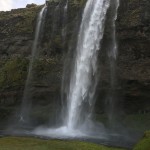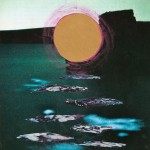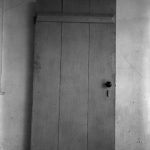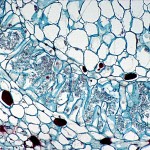Last week, I attended a conference in Reykjavik for my job, and my husband and I were able to see some of the country. I’m not a travel writer, but this series is an effort at sorting through the thoughts I have about the wonderful things I saw (and not-so-wonderful things that happened during the trip). Click here for part 1: Water.
Part 2: Earth
Before I left, I prepared by reading up on Icelandic lore. I read Snorri Sturluson’s Prose Edda (I’d read the Poetic Edda a few years before) and a book of Icelandic folktales called Hildur, Queen of the Elves by J.M. Bedell. On our second day in the country, when my husband and I rented a car to see the Golden Circle, I told him some of the stories I’d read in the book. One of my favorites, “Búkolla,” is about a she-troll who steals a family’s cow. When the son of the family steals the cow back, the troll chases them and the cow tells the son to put a hair from her tail on the ground. It grows into a river, but the troll has her bull drink it up. The boy sets down another hair, which grows into an inferno, but the bull puts it out with all the pee he’s stored up from drinking the river. Finally, the boy puts down a hair that grows into a mountain, and the troll tries to drill through it, but she gets stuck halfway in the hole. When the sun rises, she turns to stone. During our travels in the countryside, I saw a mountain with a humanoid rock formation sticking out of it.
One of the best ways, I think, to understand a culture’s mythology is to engage with its landscapes. Of all the characters that inhabit Icelandic folklore, the Huldufólk (Hidden People) are the most prominent, living within the hills. In multiple stories, voices can be heard if one puts their ear to the ground.
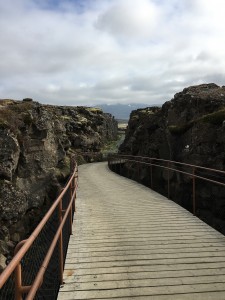
Our first stop on the Golden Circle was Þingvellir, where Icelandic chieftains held their annual parliament and the North American and Eurasian tectonic plates meet. Walking between the continental plates is a heady experience in itself, but what really took my breath away was when I happened to thump my hand on the ground. The thump was resonant. The ground sounded hollow. And just like that, the stories of the Huldufólk made perfect sense.
Of course, it was hard to feel their presence when I was surrounded by other tourists, as I talked about in my last post. But the next day we went to Þórsmörk.
Þórsmörk, or “Thor’s Forest,” is a remote nature preserve accessible only by 4-wheel-drive busses that can ford rivers. It’s surrounded by a gravelly plain threaded with rivulets, and fording them was terrifying; each time the bus went through a rivulet, it rocked from side to side and I thought that it would tip over and crush me. Within the preserve, though, there’s a peaceful low birch wood surrounding Valahnúkur mountain. There are still tourists there, of course, but few enough that the trails aren’t too crowded.
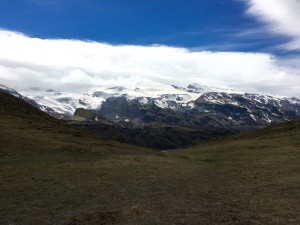
When we were about halfway up Valahnúkur, we came upon a broad hilltop covered in short grass, with the glacier Eyjafjallajökull beyond. The landscape was silent except for the occasional birdcall, and I sat down on the hill to find that it, like the trail between the plates, sounded hollow. I lay down on the earth and sent respect and good wishes to the Huldufólk inside. It felt viscerally good to lie on the earth and listen to the silence. I didn’t want to leave. When we got a little higher, I looked back down at the hill and saw that it was indeed hollow on the north side, carved out by erosion patterns that looked like windows and doors. At the bottom of the mountain we saw the Alfakirkja, or Elf Church: a hollow rock formation with what looked like spires at the top.
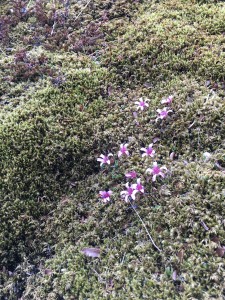
It was a 7-hour round trip from Reykjavik to Þórsmörk, which meant that we spent twice as much time traveling as we did at the site. But I’d do it again in a heartbeat, even with the terror of fording those rivers. I felt like a humble guest in Thor’s forest, a sanctuary he’d set aside for himself and protected with rivers.
***
As a knitter, I arrived in Reykjavik ready to do some serious yarn shopping.
As luck would have it, we arrived right within the few weeks during which southern Iceland is crawling with sheep and baby lambs, so we saw hundreds of lambs around the countryside. (We also saw lamb stew for sale in every restaurant, but I’m trying not to dwell too much on that.) Because of its healthy supply of wool, yarn is the one thing in Iceland that doesn’t cost a bajillion dollars. In fact, it’s about 5 times cheaper than comparable wool in the US. In Reykjavik, I went to the Handknitting Association yarn shop and Storkunnin, and came home with a huge bag full and wondered if I should have bought even more. The Handknitting Association was packed with people–mostly women–from Iceland and abroad all buying Iceland’s iconic Lopi yarn, and it was pleasant to find myself among kindred spirits when I was so far from home. Before leaving home, I’d printed out the specs for my next lace project, and I bought some lovely blue einband yarn for it, along with other varieties of Lopi for smaller projects: a scarf for my daughter and a couple of hats or pairs of mitts for myself.
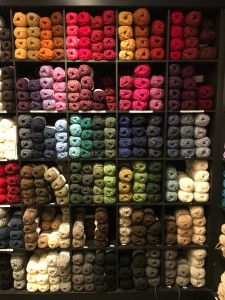
This knitting blog has excellent descriptions of Icelandic wool and knitting traditions, so I won’t attempt to replicate it here. Instead, I’ll say that nothing makes me feel connected to my ancestors quite like knitting does. I feel that connection when my fingers are moving swiftly and comfortably, adding row upon row to a project; I feel it when I watch the YouTube tutorials that women have created for tricky or obscure techniques. I feel it when I do Fair Isle colorwork or Estonian lace. I feel it when a project is finished, lying stretched and blocked on the floor. When I knit with natural fibers, I feel a connection to the grass that fed the sheep that was shorn, the people who cleaned and carded and spun and dyed the wool, the designer who created the pattern I’m using. I feel a connection with the descendants who will inherit the lace shawls that I’ve made. When I knit, or lie on hills, or walk between the plates that are the skin of the earth, I feel something much deeper and more ancient than the gods we’ve named–even as I feel the presence of those gods.
Next in this series: Fire, with sulfur, volcanoes, and news of a shooting at my campus back home.
Click here to follow Asa West on Facebook, and click here to book a tarot reading!

